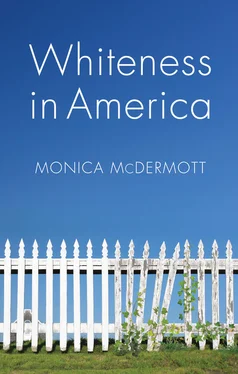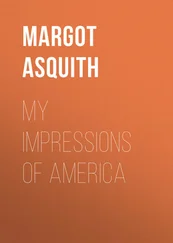Important contextual effects that vary across cities—such as demographics, segregation, or inequality—can also vary across neighborhoods within a single city. Doering’s (2015) study of “positive loiterers”—whites who congregate in public in order to deter people from criminal activity—shows that whites located in multiracial contexts have a visibility to their whiteness that others—whites in homogenous neighborhoods, or in less public settings—do not. The ways in which these whites navigate their identities varies. One group anticipated racial challenges and engaged with critics, while another isolated itself from blacks in the neighborhood and dismissed those who confronted it. These cases point to the importance of context in shaping expressions of whiteness (Doering 2015).
Although context is certainly important in shaping white identities, the reach of whiteness transcends the particular and is both the cause and the consequence of the larger structural forces that shape identities. While it might seem unusual to assert that an identity can change a structural force, political and economic conditions can be reinforced, or even transformed, by the patterned behaviors of whites as they enact their identities. For example, white superiority can facilitate the passage of legislation that results in the criminalization or disenfranchisement of non-whites. This legislation, in turn, can solidify, or even generate, whites’ feelings of moral superiority over other racial groups. So, too, can broader patterns of residential segregation influence whiteness. For example, racial segregation can mitigate against positive attitudes to immigration among whites (Rocha and Espino 2009). Similarly, racially homogenous neighborhoods can undergird a sense of having rights to certain areas, which are then thought to exist primarily for whites. These perceived rights can prompt white residents to call the police on a black pedestrian in “their” neighborhood. The white identities that emerge from these patterns of segregation and their corresponding behaviors, in turn, reify racialized neighborhood boundaries and have a cascading effect on the segregation of other institutions such as schools.
Colorblind identities such as those generated by racially homogenous neighborhoods are reflected in whites’ inability to see their own race as an important factor in their lives. Race is instead thought to be a characteristic that non-whites have; whites simply do not think of themselves as having a race at all. One of the reasons why whiteness often goes unremarked is the widely held assumption that “white” is the norm—the default racial category in America. This reality is generated by a long history of white racial dominance, in which whites have controlled institutions, shaped the culture, and enforced their power through a variety of mechanisms. As a result, they have been in a position to defend their rights and power by drawing boundaries around their group, such that white became the norm and all other groups fell outside of the norm. The invisibility of whiteness is such that the privilege it involves is often hidden from view—it seems like the natural order of things. This invisibility of whiteness is especially common among whites in racially homogenous settings: when white is the norm and no stimulus is activating racial identity, one’s own race is seen as a non-factor. Given the high degree of residential and educational segregation in the United States, this experience of whiteness is, indeed, the “norm.”
As discussed earlier, privilege refers to the often unseen benefits of occupying a structurally rewarded position in society such as being white, or male, or heterosexual. The benefits of privilege are many, ranging from a greater likelihood of earning extra income to a greater likelihood of getting away with shoplifting than those without privilege. The very category of “white” is based on the existence of privilege in relation to people of color. The boundaries of whiteness have reflected a history of groups striving for inclusion in the category of “white” and the corresponding high status and resources that being white bestows (Roediger 1991). To be white is to have the opportunity to be included in the civic, political and economic life of the nation. White is the default category against which other racial and ethnic groups are measured. Yet few of those within this category see their racial experience as anything but the norm; it is the others whom they regard as different.
Among the first to observe this power of whiteness in America was the sociologist W. E. B. DuBois. In The Souls of White Folk , DuBois noted that the overt racial dominance claimed by the white race ultimately came to manifest itself in subtler ways, as the notion that all that is right, good, and powerful equals white came to be taken for granted.
How easy … by emphasis and omission to make children believe that every great soul the world ever saw was a white man’s soul; that every great thought the world ever knew was a white man’s thought; that every great deed the world ever did was a white man’s deed; that every great dream the world ever sang was a white man’s dream. (DuBois 1996: 498)
The books and lessons children of all races receive have been filled with white faces, the images representing America are white faces (such as that of Uncle Sam), and “white” is rarely used as a racial descriptor. One hears of a “black scientist” or a “Mexican actor” but not of a white scientist or white actor—the whiteness of scientists and actors is often simply assumed.
However, some whites have a strong sense of their own racial identity. Rather than assuming that they are simply people without any race, they are instead acutely aware of the role that whiteness plays in their lives. White identity can actually have a negative impact on individuals’ sense of self. For example, poor and working-class whites can be negatively affected by their racial identity when they are judged harshly by others for not capitalizing on the socioeconomic benefits of whiteness (Hartigan 1999; McDermott 2006). Indeed, social class can have a major impact on how whites understand their racial identities. The stigma of poverty attaches to every low-income person regardless of race, but poor whites must deal with an additional judgment. Since whiteness is associated with affluence and privilege, poor whites are often seen as being especially damaged or defective. If they were “real” whites, who work hard and are intelligent, they would have moved up and out of poverty. Whites are effectively seen as having no excuse for being poor, since their skin color should have guaranteed better socioeconomic outcomes (McDermott 2006). The combined stigma against poor whites is so prevalent that a special term—“white trash”—has emerged to dismiss and malign whites with little money or education.
Whites can feel stigmatized for their white identity from a quite different source—one not related to social class directly. As mentioned previously, “white guilt” can manifest itself when individuals confront the reality of their privilege and are aware of the undeserved advantages it has brought and continues to bring in their lives. Despite there being no mismatch between their socioeconomic status and their racial identity, these whites nonetheless attach a negative valence to the latter. Especially among non-whites and among white anti-racist activists, whiteness itself can be an inherently stigmatized identity. Some anti-racist activists actually engage in strategies in order to embrace this stigma (Hughey 2012a). The mixed-race women that Storrs (1999) interviewed took the opposite approach; although all the women had white ancestry, they were disgusted by whiteness as “oppressive, patriarchal and discriminatory” (Storrs 1999: 196).
Читать дальше












